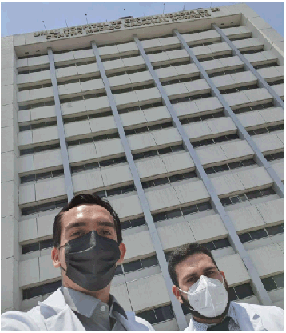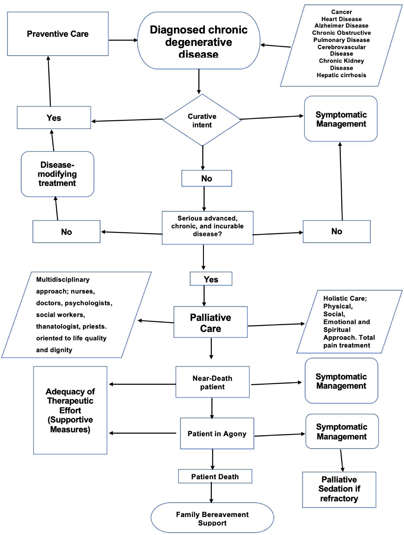A New Experience.

Legend: The UMAE #25 in the background, with the interns of the palliative care unit, Alejandro Saénz (left) and Patricio García-Espinosa (right).
doi: http://dx.doi.org/10.5195/ijms.2021.1145
Volume 10, Number 1: 92-94
Received 03 08 2021: Rev-request 25 08 2021: Rev-request 01 10 2021: Rev-recd 25 08 2021: Rev-recd 26 10 2021: Accepted 03 11 2021
I have recently started to develop myself in a role of a medical intern performing my social service year in one of the largest medical units in the north of Mexico, the “Unidad Médica de Alta Especialidad #25” (High Specialty Medical Unit #25). As a highly specialized tertiary-level center, it is the second largest hospital in metropolitan area of Mexico. In this exact institution I have chosen an internship on the palliative care ward, being the first time that this position has been open for undergraduate physicians. It has been an amazing experience, after which I have given myself the task of reflecting on what I have done so far. Firstly, I have had contact with patients to whom I had not had the opportunity to provide care during my previous years of training. At the same time, I have handled medications such as opioids, to which I had not had access before. Additionally, I have reinforced the practice of delivering bad news, always accompanied, and instructed, by attending physicians and by last year residents of anesthesiology, geriatrics and family medicine who rotate through this unit. These residents can perform the sub-specialty of pain management and palliative care in Mexico, which is why they do part of their fellowship rotations on this ward. In international literature, there is much talk about the role we, undergraduate students, play as part of the palliative care team. This has been pointed out in case of nursing education by Dimoula, M et al.1 which showed that structured undergraduate palliative care courses could be a core element in the healthcare system. In addition, Oliveria, S. et al.2 in 2020 at the University of Coimbra, emphasized that, despite agreeing with the importance of palliative care, fifth year medical students did not feel properly trained, nor had sufficient knowledge about this subject.
Weber, M. et al.3 has described in Germany, that undergraduate medical students felt limited in their confidence when approaching palliative medicine. At the same time, they emphasize the limited knowledge of the subject, concluding that its introduction in the curricula of undergraduate students is necessary.
Surprisingly for me, there is in fact, a study emulating the perception of medical students towards palliative care in Mexico. More precisely, students at the highest ranking national university, the “Universidad Nacional Autónoma de México”, conducted a study in 2020 by Allende-Pérez S. et al.4 It revealed not only the perception on the lack of skills of undergraduate physicians, but also their inability to cope with given scenarios in palliative care settings, their interest in making this a compulsory course, and finally their dissatisfaction because it is not included in their current medical curriculum.
I began my studies in palliative care in the sixth semester (third year of medical school), which was more than 3 years ago.
During this time, I have learned that palliative care has the goal of focusing on improving patients' life quality at its end-stage, providing them with freedom, dignity, and greater autonomy in their final moments through the relief of symptoms such as pain, dyspnea, and delirium. In case of refraction, palliative sedation may even be indicated.
Relief of symptomatology, limiting therapeutic obstinacy, and focusing on human dignity, were the reason why I decided to perform my social service year in the palliative care unit.
I have seen that there are physicians who are reluctant to limit efforts of medical care, especially pediatricians, because they consider that, unlike adult patients, pediatric patients have not lived their fullest lives yet. However, there have been situations where therapeutic obstinacy is highly present. For example, in a setting of starting chemotherapy in patients with advanced disease progression, without the possibility of curative treatment, I have observed a patient cases of bilateral Wilms tumor, and acute myeloid leukemia. The death of the patients was inevitable and there were problems in communication between treating services and family members, making the process even more complicated.
On the other hand, I have seen the sadness of a mother when she is told that her daughter's or son's time to go has come, and that this process can be made easier for them with adequate communication, showing signs of gratitude.
It is important to have a good support network, and that the caregiver must also be cared for to avoid burn-out.
Being part of the first generation to be allowed to rotate in the pain management and palliative care unit has been an experience that has allowed me to learn and see things that we, as undergraduates, sometimes avoid. Unique end-of-life medica care, has led me to agree with the previously cited authors.1,2,3,4
It is necessary to be interested in seeking, learning, and understanding palliative care as undergraduate students, and not only the curative medical approach. For example, the case of a 46-year-old male patient, who had not been able to sit up since his diagnosis of rectal cancer 3 years ago, due to the pain it caused him, has underwent lysis of cauda equina and after 2 weeks the patient reported 2/10 pain score, and improvement in his quality of life, calling it a “miracle of science”. It is important to emphasize that opioids are wonderful drugs and that we should not be afraid of their use; on the contrary, it is important to highlight their capacity to alleviate the pain and suffering of a patient and even of a family. Figure 1 shows the first interns in this service.
Figure 1.A New Experience.

I would like to emphasize the words of De Antueno and Silberberg in 2018.5 One of the situations that will be responsible for producing greater suffering in life, is precisely the disease, which is accompanied by biological, social, and psychological factors. When curative treatment is no longer an option, there is always something left for the medical team to do; such as initiating palliative care (Figure 2). I must emphasize that research in this area is still scarce, and that the more research and improvement is being made, the more can be done to improve end-of-life care quality. Death of a patient, after all, is a collaborative work between the general physician, the nurse who is also often a thanatologist, and finally, most importantly, the family.
Figure 2.Palliative Care Flowchart.

Título: Experiencia en una Unidad de Cuidados Paliativos en un Hospital Mexicano de Tercer Nivel
Problema Principal: El rol olvidado en la licenciatura de medicina del cuidado de los pacientes que cursan la última etapa de la vida y se aproximan al final de esta y cuya función es de los cuidados paliativos.
Propósito: A través de la presente experiencia, busque el exponer el rol de los cuidados paliativos en un hospital de alta especialidad en la segunda ciudad metropolitana más grande de México en el papel de un Médico Pasante del Servicio Social.
Metodología: Se expone la experiencia en los cuidados paliativos tanto del adulto como del paciente pediátrico, se realiza un acercamiento al rol del médico paliativista en el manejo de la sintomatología y los problemas que se puede atravesar al momento de llevar a cabo la función propia de una especialidad que se encuentra en un crecimiento reciente en el contexto mexicano.
Resultados: Acercamiento del rol del médico paliativista y la multidisciplinariedad que significa esta disciplina; un acercamiento al rol que se tiene como Médico Pasante del Servicio Social del sistema de salud mexicano y la colaboración entre residentes de último año que pueden optar por la subespecialidad en cuidados paliativos, incluyendo residentes de Medicina Familiar, Geriatría y Anestesiología (otros residentes que pueden optar a la subespecialidad son los oncólogos, pero no está regulado en el Instituto Mexicano del Seguro Social); se hace especial énfasis en la falta de práctica en el pregrado de medicina alrededor de los cuidados paliativos, la importancia de la comprensión de los conceptos de limitación del esfuerzo terapéutico y la necesidad de evitar la obstinación terapéutica, principalmente en pediatría.
Conclusión: Se encuentra como una necesidad imperiosa, el exponer los cuidados paliativos como medidas deseables, además de incentivar la producción academica en el campo del conocimiento y la investigación en los estudiantes de pregrado de medicina, no solamente incentivar el enfoque curativo de la medicina; además de concientizar sobre el correcto uso de analgésicos opioides en busca de aumentar la calidad de vida del paciente y su familia, además de aliviar el sufrimiento en las esferas biológicas, psicológicas, sociales y espirituales, con un enfoque multidisciplinario.
None.
The Authors have no funding, financial relationships or conflicts of interest to disclose.
Conceptualization, Data Curation, Formal Analysis, Funding Acquisition, Investigation, Methodology, Project Administration, Resources, Software, Supervision, Validation, Visualization, Writing – Original Draft Preparation, Writing – Review & Editing: PG.
1. Dimoula M, Kotronoulas G, Katsaragakis S, Christou M, Sgourou S, Patiraki E. Undergraduate nursing students' knowledge about palliative care and attitudes towards end-of-life care: A three-cohort, cross-sectional survey. Nurse Educ Today. 2019 Mar;74:7-14.
2. Oliveira S, Santiago LM, Dourado M. Conhecimento sobre Cuidados Paliativos em Estudantes de Medicina da Universidade de Coimbra [Knowledge of Palliative Care Among Medical Students of the University of Coimbra]. Acta Med Port. 2020 Aug 27. Portuguese
3. Weber M, Schmiedel S, Nauck F, Alt-Epping B. Knowledge and attitude of final - year medical students in Germany towards palliative care - an interinstitutional questionnaire-based study. BMC Palliat Care. 2011 Nov 23;10:19.
4. Allende-Pérez, Silvia, et al. [Basic knowledge and perceptions in palliative care in undergraduate physicians at the National Autonomous University of Mexico: a cross-sectional study]. Med. Paliat. 2020Apr-Jun;71-78.Spanish
5. de Antueno P, Silberberg A. [Efficacy of Palliative Care in Pain Relieving]. 2019 Jun;22(2):367-80. Spanish
Patricio García-Espinosa, School of Medicine, Universidad Autónoma de Nuevo León, Monterrey. México.1
2 Mexican Institute of Social Security. Palliative Care Unit. High Specialty Medical Unit #25, Nuevo Léon, Monterrey. México.
About the Author: García-Espinosa, Patricio. He is currently a medical intern in his social service year at the Mexican Social Security Institute (IMSS).
Correspondence: Patricio García-Espinosa. Address: School of Medicine, Universidad Autónoma de Nuevo León, Monterrey. México. Email: patricio.garciaes@uanl.edu.mx
Editor: Francisco J. Bonilla-Escobar. Student Editors: Shuo-Yan Gau, Manas Pustake, Nikoleta Tellios, Leah Komer, Vinson Chan. Copyeditor: Adnan Mujanovic. Proofreader: Michael Tavolieri. Layout Editor: Sushil Dahal. Process: Peer-reviewed.
Cite as: García-Espinosa, P. Experience in a Palliative Care Unit in a Mexican Tertiary Level Hospital. Int J Med Stud. 2022 Jan-Mar;10(1):92-94.
Copyright © 2022 Patricio García-Espinosa
This work is licensed under a Creative Commons Attribution 4.0 International License.
International Journal of Medical Students, VOLUME 10, NUMBER 1, Jan-Mar 2021